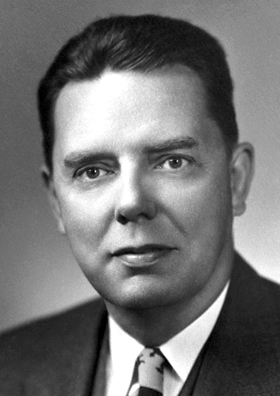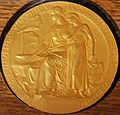Philip Showalter Hench facts for kids
Quick facts for kids
Philip Showalter Hench
|
|
|---|---|
 |
|
| Born | February 28, 1896 |
| Died | March 20, 1965 (aged 69) Ocho Rios, Jamaica |
| Alma mater | Lafayette College University of Pittsburgh |
| Known for | Discovery of cortisone |
| Awards | Nobel Prize in Physiology or Medicine (1950) |
| Scientific career | |
| Fields | Medicine |
| Institutions | Mayo Clinic |
Philip Showalter Hench (born February 28, 1896 – died March 30, 1965) was an American doctor. He is famous for his work on cortisone. This is a special hormone that helps treat rheumatoid arthritis.
In 1950, Dr. Hench won the Nobel Prize in Physiology or Medicine. He shared this big award with his colleague Edward Calvin Kendall from the Mayo Clinic. They also shared it with Swiss chemist Tadeus Reichstein. They all won for finding cortisone and showing how it could treat arthritis.
Dr. Hench studied at Lafayette College and the University of Pittsburgh. He became a doctor and later joined the Mayo Clinic in 1923. He eventually led the Department of Rheumatology there.
Contents
Early Life and Schooling
Philip Hench went to Lafayette College in Easton, Pennsylvania. He earned his first degree there in 1916. After college, he joined the U.S. Army Medical Corps. This helped him finish his medical training.
He then earned his doctorate in medicine in 1920. This degree was from the University of Pittsburgh School of Medicine. After getting his medical degree, Dr. Hench worked as an intern for a year. This was at St. Francis Hospital in Pittsburgh. Next, he became a special researcher at the Mayo Foundation.
In 1928 and 1929, Dr. Hench continued his studies. He went to Freiburg University in Germany. He also studied at the von Müller Clinic in Munich.
His Medical Work
Dr. Hench started working at the Mayo Clinic in 1923. He joined the Department of Rheumatic Diseases. By 1926, he became the head of this important department.
At the Mayo Clinic, Dr. Hench focused on arthritis. He believed that certain steroids could help reduce the pain from this disease. Around the same time, a biochemist named Edward Calvin Kendall was working too. Kendall had found several steroids made by the adrenal gland.
After many years, Hench and Kendall decided to test one of these steroids. They wanted to see if it would help patients with rheumatoid arthritis. The testing was delayed for a while. Making the steroid, called Compound E, was very expensive. Also, Dr. Hench served in the military during World War II.
Finally, the tests were done in 1948 and 1949. They were very successful! The steroid they used was first called Compound E. Later, it became known as cortisone.
Nobel Prize and Other Awards
In 1950, Dr. Hench, Dr. Kendall, and Swiss chemist Tadeus Reichstein won the Nobel Prize in Physiology or Medicine. They won for their discoveries about hormones from the adrenal cortex. These hormones and their effects on the body were very important.
Dr. Hench was also a founder of the American Rheumatism Association. He was its president in 1940 and 1941.
He received many other awards during his career. These included the Heberdeen Medal (1942) and the Lasker Award (1949). He also got the Passano Foundation Award (1950) and the Criss Award. Several universities gave him honorary doctorates. These included Lafayette College and the University of Pittsburgh.
Images for kids
See also
 In Spanish: Philip Showalter Hench para niños
In Spanish: Philip Showalter Hench para niños


